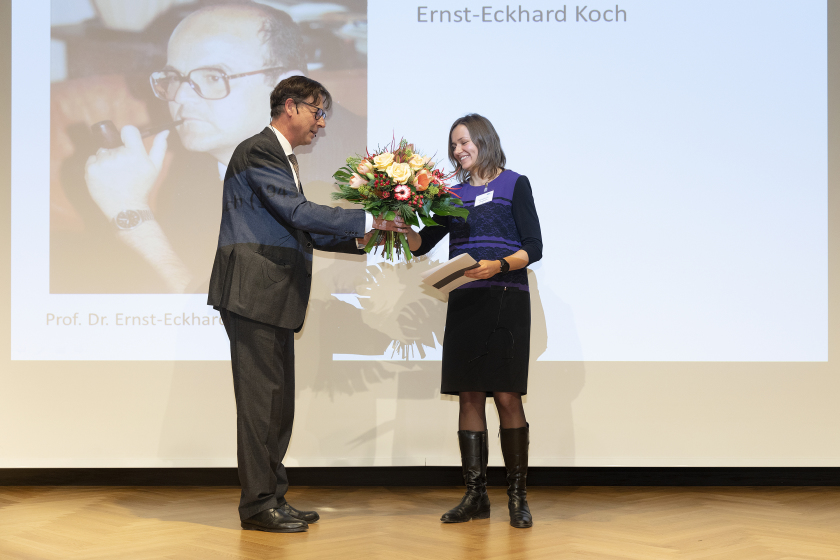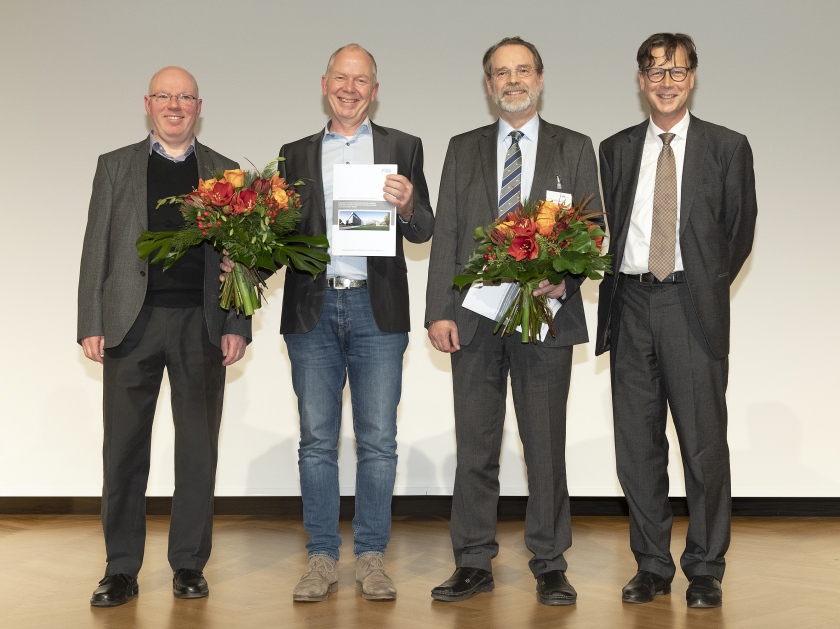Ernst Eckhard Koch Prize and Synchrotron Radiation Innovation Award

The Ernst Eckhard Koch Prize went to Dr. Victoriia Saveleva (right) for her work on catalysts. © M. Setzpfandt/HZB

Laudator Prof. Gerd Schneider, award winners Dr. Christian David and Prof. Alexei Erko and Prof. Mathias Richter, Friends of HZB, (From left to right). © M. Setzpfandt/HZB
On December 6, 2018, the Association of Friends of Helmholtz-Zentrum Berlin awarded the Ernst Eckhard Koch Prize for an outstanding doctoral thesis in the field of research with synchrotron radiation at the HZB or at DESY as well as the European Innovation-Award on Synchrotron Radiation. The award ceremonies took place during the 10th User Meeting at the HZB.
The decisions between excellent proposals have not been easy for the two selection committees, Prof. Mathias Richter, chairman of the “Friends of HZB” pointed out.
The Ernst Eckhard Koch Prize went to Dr. Victoriia Saveleva for her doctorate at the University of Strasbourg on in-situ investigations of electrochemical processes using photoemission spectroscopy. Her experiments at BESSY II focused on reactions on catalyst surfaces of ruthenium and iridium during the electrolytic decomposition of water. Saveleva is now a postdoctoral researcher at the Paul Scherrer Institute in Switzerland.
The Innovation Award on Synchrotron Radiation 2018 went to Dr. Christian David, also from the Paul Scherrer Institute, and to Prof. Alexei Erko, who recently moved from the HZB to the Institute for Applied Photonics (IAP) in Berlin-Adlershof. The two physicists were honored for their innovative contributions to the application of diffractive X-ray optics, which enable complex X-ray experiments with high resolution. The laudation was held by Prof. Gerd Schneider from the HZB. This time it was not the "ring makers" who were honoured for developing the accelerators, but those who had cut the "diamonds for the ring", Schneider explained pictorially. The Synchrotron Radiation Innovation Award is sponsored by SPECS GmbH and BESTEC GmbH.
arö
https://www.helmholtz-berlin.de/pubbin/news_seite?nid=20231;sprache=en
- Copy link
-
Ernst Eckhard Koch Prize and Innovation Award on Synchrotron Radiation 2025
At the 27th BESSY@HZB User Meeting, the Friends of HZB honoured the dissertation of Dr Enggar Pramanto Wibowo (Friedrich-Alexander University Erlangen-Nuremberg). The Innovation Award on Synchrotron Radiation 2025 went to Prof. Tim Salditt (Georg-August-University Göttingen) and Professors Danny D. Jonigk and Maximilian Ackermann (both, University Hospital of RWTH Aachen University).
-
Synchrotron radiation sources: toolboxes for quantum technologies
Synchrotron radiation sources generate highly brilliant light pulses, ranging from infrared to hard X-rays, which can be used to gain deep insights into complex materials. An international team has now published an overview on synchrotron methods for the further development of quantum materials and technologies in the journal Advanced Functional Materials: Using concrete examples, they show how these unique tools can help to unlock the potential of quantum technologies such as quantum computing, overcome production barriers and pave the way for future breakthroughs.
-
Peat as a sustainable precursor for fuel cell catalyst materials
Iron-nitrogen-carbon catalysts have the potential to replace the more expensive platinum catalysts currently used in fuel cells. This is shown by a study conducted by researchers from the Helmholtz-Zentrum Berlin (HZB), Physikalisch-Technische Bundesanstalt (PTB) and universities in Tartu and Tallinn, Estonia. At BESSY II, the team observed the formation of complex microstructures within various samples. They then analysed which structural parameters were particularly important for fostering the preferred electrochemical reactions. The raw material for such catalysts is well decomposed peat.
